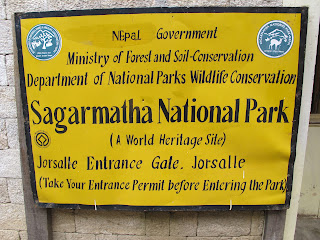For me, the trek
to Everest Base Camp (EBC) is what I would call "luxury trekking."
This is because, in my world, trekking (or what I would normally call
hiking/backpacking), consists of carrying a heavy backpack, sleeping in a tent
on the ground, and cooking all your own food. Teahouse trekking includes a
porter to carry your gear, a bed of some sort to sleep in, and a wood stove
heated dining room in which to consume the meals that someone else prepares for
you three times a day. Plus endless cups of steaming tea when you walk in off
the trial.
With daily camp duties remove, this left lots of time for recreational reading, a concept I am HIGHLY enjoying indulging in after so many years in academia where I started to consider reading scientific journal articles not directly related to my thesis as "recreational." I read a book called Buddhas Orphans by Samrat Upadhyay. An interesting novel which intertwines half a century of Nepals political and social history with a fictional story about middle class Nepalis while vividly describing Kathmandu. I quickly finished that and on a layover/acclimatization day in the village of Dingboche, traded it for A Suitable Boy by Vikram Seth, a 1,500 page Indian novel which I'll be luck to finish by the time I leave Asia, I let the porter carry that one.
Its hard to complain about the luxury, but it does provide that many more people come to this region than would otherwise. We started hiking on the early end of the trekking season March 31. While we didn't have the trail to ourselves, there weren't mobs of people either. You could trek at least a little way with out seeing others. We did however share the trail with multitudes of donkeys, yaks, and dzope- a cross between yak and cow pronounced jopeh.
On the way back
it did seem like there were far more people on the trail than on the way up,
but that can also happen when the weather is bad a no flights can land in Lukla
for a few days, causing large pulses of trekkers. I enjoyed meeting people from
all around the world on the trail and getting to chat with others in the
guesthouses while relaxing by the wood stove. We were on roughly the same
itinerary with a group from Hong Kong staying in many of the same lodges and
independent trekkers from many other places. Closely mirroring our itinerary,
but thankfully not staying in the same lodges, was a group of about 30 high
school boys from the UK. I also met a 29 year old woman from Bangladesh who is
attempting to climb the 7 Summits (highest peaks on each of the 7 continents).
Visit her Women
Reaching Heights website for some inspiration and find her on
Facebook at Bangladesh on 7 Summits.
Here are a few photos from the trail:
With daily camp duties remove, this left lots of time for recreational reading, a concept I am HIGHLY enjoying indulging in after so many years in academia where I started to consider reading scientific journal articles not directly related to my thesis as "recreational." I read a book called Buddhas Orphans by Samrat Upadhyay. An interesting novel which intertwines half a century of Nepals political and social history with a fictional story about middle class Nepalis while vividly describing Kathmandu. I quickly finished that and on a layover/acclimatization day in the village of Dingboche, traded it for A Suitable Boy by Vikram Seth, a 1,500 page Indian novel which I'll be luck to finish by the time I leave Asia, I let the porter carry that one.
Its hard to complain about the luxury, but it does provide that many more people come to this region than would otherwise. We started hiking on the early end of the trekking season March 31. While we didn't have the trail to ourselves, there weren't mobs of people either. You could trek at least a little way with out seeing others. We did however share the trail with multitudes of donkeys, yaks, and dzope- a cross between yak and cow pronounced jopeh.
 |
| This dzope brought to you by Gore-Tex! |
 |
| The trail was yak-tastic, but I don't really need to be able to buy a Coca-Cola, Pringles, and a Snickers bar at 17,000 ft. |
 |
| One foggy morning with 3 inches of snow the night before, we followed the sounds of the yak bells to keep from losing our way. |
This year is the
50th Anniversary of the first American (James Whittaker) summit of Mt. Everest.
Because of this, Outside Magazine sent one of its senior editors to blog from base camp about everything from the
effects of tourism on the Khumbu region to the Everest Ultramarathon to a S.
African guy who is attempting to swim across a glacial lake near the camp to
raise awareness about climate change. James Whittaker, now 84 years old, was on
the EBC trail this year to commemorate the anniversary. Here is a National Geographic article about his legacy,
although it was published on the 40th anniversary, its still a good story.
While there is
always great respect for those who summit Mt. Everest, it is important to
remember that their success wouldn't be possible if not for the hundreds, maybe
thousands, of Sherpa porters and local support that expeditions hire and rely
on. Two Sherpas have been declared National Geographic's Adventurers of the Year for 2012. This title was
earned by successfully climbing Mt. Everest, paragliding from the summit, and
kayaking down the Ganges River to the Indian Ocean.
Here are a few photos from the trail:
 |
| Sherpa child |




No comments:
Post a Comment